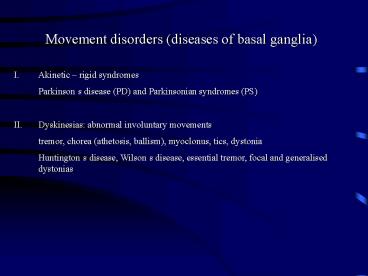Movement disorders diseases of basal ganglia - PowerPoint PPT Presentation
1 / 19
Title:
Movement disorders diseases of basal ganglia
Description:
tremor, chorea (athetosis, ballism), myoclonus, tics, dystonia. Huntington's disease, Wilson's disease, essential tremor, focal and generalised dystonias ' ... – PowerPoint PPT presentation
Number of Views:859
Avg rating:3.0/5.0
Title: Movement disorders diseases of basal ganglia
1
- Movement disorders (diseases of basal ganglia)
- Akinetic rigid syndromes
- Parkinsons disease (PD) and Parkinsonian
syndromes (PS) - Dyskinesias abnormal involuntary movements
- tremor, chorea (athetosis, ballism), myoclonus,
tics, dystonia - Huntingtons disease, Wilsons disease,
essential tremor, focal and generalised dystonias
2
An Essay on the Shaking Palsy James Parkinson,
London,1817 Parkinsons Disease Charcot,
Paris, 188..
3
Parkinsons disease slowly progressive disease
producing an akinetic - rigid syndrome, usually
with rest tremor, and accompanied by many other
motor and non motor disturbances including a
flexed posture, a shuffling gait, postural
instability or depression, dementia and autonomic
failures Degenerative cell loss in s. nigra with
inclusions (Lewy bodies) degeneration of the
nigrostriatal pathway Dopamine deficit in
mesostriatal, mesocortical (frontal,limbic) and
hypothalamic dopaminergic systems
4
Parkinsons disease Major features brady - /
hypokinesia rigidity rest tremor loss of
postural reflexes Diagnosis presence 2 of the
main symptoms
5
Parkinsons disease Variable features Motor
posture, body bradykinesia, freezing of gait,
dystonia, muscle ache, speech, micrography Autono
mic urinary frequency, constipation, impotence,
orthostatic hypotension Cognitive depression,
slowness in thinking (bradyphrenia), dementia
(subcortical or frontal type)
6
Clinical subtypes of PD Akinetic rigid
type Tremor dominant type Mixed or equivalent
type (importance concerning therapy and prognosis)
7
Clinical manifestation of PD Unilateral
onset Rest tremor Absence of other neurological
signs (spasticity, Babinski sign etc) Absence of
laboratory or radiologic (but functional imaging,
F-dopa PET) abnormalities Slow progression Dramati
c response to levodopa Preservation of postural
reflexes early in the illness
8
Hoehn Yahr stages Stage 0 no signs of
disease Stage 1 unilateral disease Stage
1.5 unilateral plus axial involvement Stage
2 bilateral disease without impairment of
balance Stage 2.5 mild bilateral disease with
recovery on pull test Stage 3 mild to moderate
bilateral disease, some postural instability,
physically independent Stage 4 severe disability,
still able to walk or stand unassisted Stage
5 wheelchair or bedridden unless aided
9
Hoehn Yahr stage how far the disease has
progressed partly independent from
functional impairment changes during
therapy UPDRS (47 items) condition of the
patient at a given time and based on
history severity, disability on
off fluctuation (score from 0 to 4)
10
Pathogenesis of PD double hit
hypothesis genetic enviromental factors ...a
pure genetic (young onset) or enviromental (old
onset) cause accounts for only a small number of
PD patients. In the majority, it is more likely
that PD results from a complex interaction among
multiple genes and proteins that may be different
in different individuals. ...patients deveolop
PD if they carry a susceptible gene defect and
have exposure to a particular toxin.
11
Factors implicated in the pathogenesis of
PD oxidative stress (MPTP model) excitotoxicity
(glutamate model) mitochondrial dysfunction
(Complex I) inflammatory factors??? glial
dysfunction???
12
Biochemical changes in PD Degenerative cell loss
in s. nigra dopamin deficit in striatum Dist
urbed neurotransmitter balance in striatum
(increased acetylcholine and glutamate
activity) Degenerative cell loss in l.
coeruleus norepinephrine deficit Degenerativ
e cell loss in raphe niclei serotonin
deficit (pharmacotherapy)
13
Classification of PS (parkinsonism) Idiopathic
or Lewy body PS (PD) PS in degenerative
disorders multiple system atrophy (MSA) MSA
P (stritonigral degeneration autonomic
disturbances) MSA C (OPCA autonomic
disturbances) urinary incontinence,
impotence, orthostatic hypotension (earlier Shy-
Drager syndrome)
14
Progressive supranuclear palsy (PSP) vertical
(downward) gaze palsy axial involvement, early
falls PS in dementias Alzhemier disease,
diffuse Lewy body disease, frontotemporal
dementia Corticobasal degeneration (CBD)
cortical signs (apraxia, cortical sensory
loss, alien limb akinetic rigid
movement disorder with dystonia
15
PS with known origin Drug induced PS (dopamin
depletion or dopamin receptor blokade/neuroleptic/
) Toxic PS (MPTP!!! Mn???) Vascular PS
(supranigral) Metabolic PS (Wilsons disease) PS
in hydrocephalus PS in prion diseases
(Creutzfeldt Jakob)
16
TREMOR Rhytmic oscillation of a body part that is
produced by alternating or synchronous
contractions of opposing muscles Classified on
basis clinical appearence distribution et
iology physiologic characters
17
CHOREA Irregular, non rythmic, rapid, unsustained
involuntary movement that flows one body part to
another. Chorea is differentiated from other
types of involuntary movements by its
unpredictable quality. Timing, direction,
distribution are not patterned but random and
changing. picture of restlessness can be
partially suppressed imcorporating them into
semipuposeful movements (parakinesias) presence
of motor impersistence (negative chorea)
dropping objects.
18
DYSTONIA .a syndrome of sustained muscle
contractions, frequently causing twisting and
repetitive movements or abnormal postures the
speed of contractions may be slow or rapid, and
the peak of movement, the contraction tends to be
sustained whatever the speed, contractions almost
always have a consistent directional or patterned
character, they are predictably present in the
affected muscle groups dystonic contractions are
usually aggravated during voluntary movements
(action dystonia) and may only be present with
specific actions such as writing
19
TICS spontaneous purposeless simple and complex
movements or vocalizations that abruptly
interrupt normal motor activity associated
sensation or urge to execute the tic and
transient relief afterward tics are temporarily
suppressible (blinking, eye rolling, mouth
opening, shoulder shrugging, head nodding,
grunting, sniffing, throat clearing, head
shaking, trunk bending, kicking and coproralia
(Tourette-syndrome)































